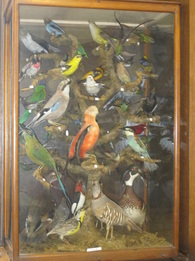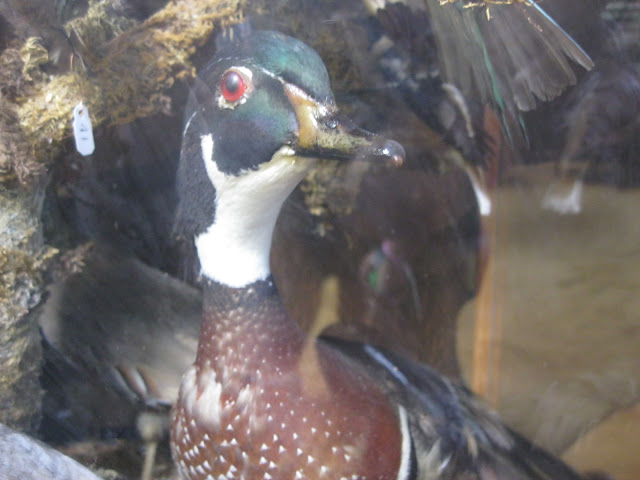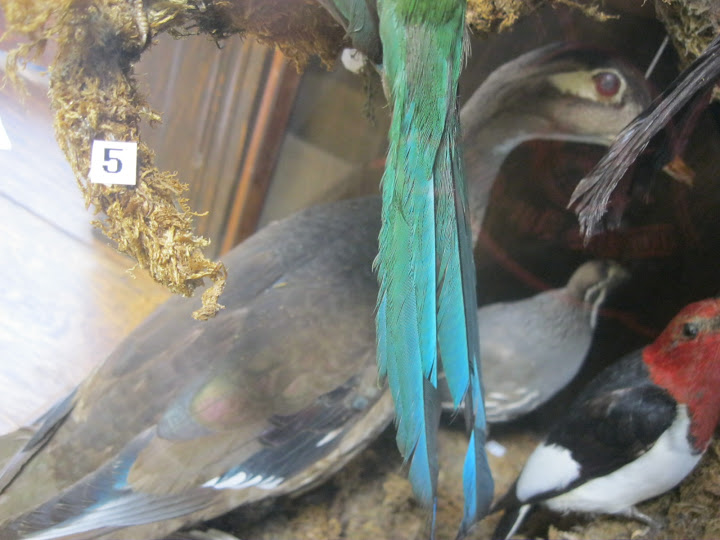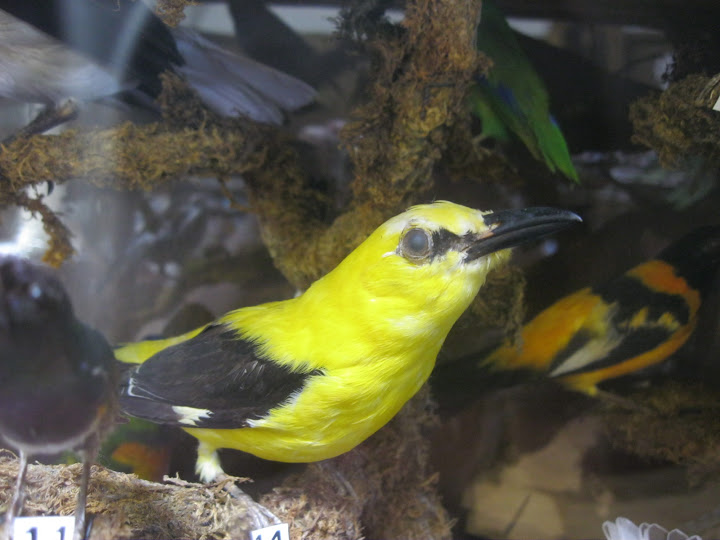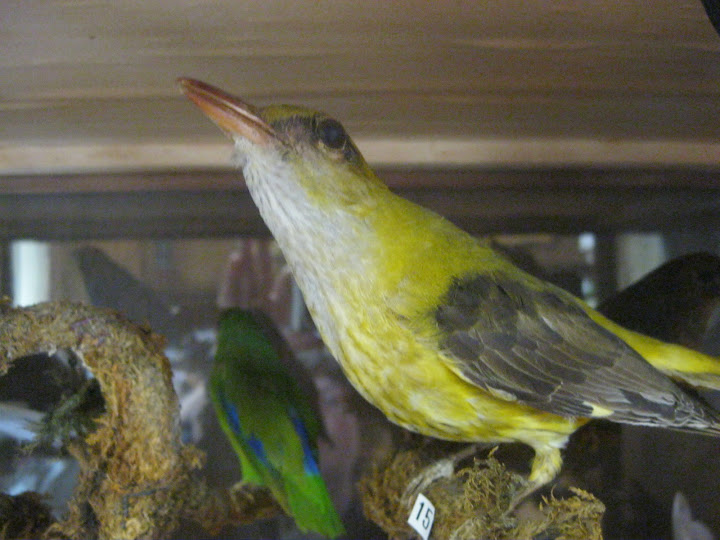Wood Duck
The Wood Duck or Carolina Duck (Aix sponsa) is a species of duck found in North America. It is one of the most colourful of North American waterfowl. Their breeding habitat is wooded swamps, shallow lakes, marshes or ponds, and creeks in eastern North America, the west coast of the United States and western Mexico. They usually nest in cavities in trees close to water, although they will take advantage of nesting boxes in wetland locations if available. Females line their nests with feathers and other soft materials, and the elevation provides some protection from predators. Unlike most other ducks, the Wood Duck has sharp claws for perching in trees and can, in southern regions, produce two broods in a single season—the only North American duck that can do so.
Females typically lay between 7 and 15 white-tan eggs that incubate for an average of 30 days. However, if nesting boxes are placed too close together, females may lay eggs in the nests of their neighbours, which may lead to nests which may contain as many as 30 eggs and unsuccessful incubation, a behaviour known as “nest dumping”.
After hatching, the ducklings jump down from the nest tree and make their way to water. The mother calls them to her, but does not help them in any way. The ducklings may jump from heights of up to 88 metres (290 ft) without injury. They prefer nesting over water so the young have a soft landing, but will nest up to 140 m (150 yd) away from the shoreline. The day after they hatch, the young climb to the nest entrance and jump to the ground. The ducklings can swim and find their own food by this time.
These birds feed by dabbling or walking on land. They mainly eat berries, acorns, and seeds, but also insects, making them omnivores.
The birds are year-round residents in parts of its southern range, but the northern populations migrate south for the winter. They overwinter in the southern United States near the Atlantic coast. 75% of the Wood Ducks in the Pacific Flyway are non-migratory.
The population of the Wood Duck was in serious decline in the late 19th century as a result of severe habitat loss and market hunting both for meat and plumage for the ladies’ hat market in Europe. By the beginning of the 20th century Wood Ducks had virtually disappeared from much of their former range. In response to the Migratory Bird Treaty established in 1916 and enactment of the Federal Migratory Bird Treaty Act of 1918, Wood Duck populations began to slowly recover. By ending unregulated hunting and taking measures to protect remaining habitat, Wood Duck populations began to rebound in the 1920s. The development of the artificial nesting box in the 1930s gave an additional boost to Wood Duck production.
Landowners as well as park and refuge managers can encourage Wood Ducks by building Wood Duck nest boxes near lakes, ponds, and streams. Fulda, Minnesota has adopted the Wood Duck as an unofficial mascot, and a large number of nest boxes can be found in the area.
Expanding North American Beaver populations throughout the Wood Duck’s range have also helped the population rebound as beavers create an ideal forested wetland habitat for Wood Ducks.
The population of the Wood Duck has increased a great deal in the last several years. The increase has been due to the work of many people constructing Wood Duck boxes and conserving vital habitat for the Wood Ducks to breed. During the open waterfowl season, U.S. hunters have only been allowed to take two Wood Ducks per day in the Atlantic and Mississippi Flyways. However, for the 2008–2009 season, the limit was raised to three. The Wood Duck limit remains at two in the Central Flyway and at seven in the Pacific Flyway. It is the second most commonly hunted duck in North America, after the mallard.(Wikipedia)
Females typically lay between 7 and 15 white-tan eggs that incubate for an average of 30 days. However, if nesting boxes are placed too close together, females may lay eggs in the nests of their neighbours, which may lead to nests which may contain as many as 30 eggs and unsuccessful incubation, a behaviour known as “nest dumping”.
After hatching, the ducklings jump down from the nest tree and make their way to water. The mother calls them to her, but does not help them in any way. The ducklings may jump from heights of up to 88 metres (290 ft) without injury. They prefer nesting over water so the young have a soft landing, but will nest up to 140 m (150 yd) away from the shoreline. The day after they hatch, the young climb to the nest entrance and jump to the ground. The ducklings can swim and find their own food by this time.
These birds feed by dabbling or walking on land. They mainly eat berries, acorns, and seeds, but also insects, making them omnivores.
The birds are year-round residents in parts of its southern range, but the northern populations migrate south for the winter. They overwinter in the southern United States near the Atlantic coast. 75% of the Wood Ducks in the Pacific Flyway are non-migratory.
The population of the Wood Duck was in serious decline in the late 19th century as a result of severe habitat loss and market hunting both for meat and plumage for the ladies’ hat market in Europe. By the beginning of the 20th century Wood Ducks had virtually disappeared from much of their former range. In response to the Migratory Bird Treaty established in 1916 and enactment of the Federal Migratory Bird Treaty Act of 1918, Wood Duck populations began to slowly recover. By ending unregulated hunting and taking measures to protect remaining habitat, Wood Duck populations began to rebound in the 1920s. The development of the artificial nesting box in the 1930s gave an additional boost to Wood Duck production.
Landowners as well as park and refuge managers can encourage Wood Ducks by building Wood Duck nest boxes near lakes, ponds, and streams. Fulda, Minnesota has adopted the Wood Duck as an unofficial mascot, and a large number of nest boxes can be found in the area.
Expanding North American Beaver populations throughout the Wood Duck’s range have also helped the population rebound as beavers create an ideal forested wetland habitat for Wood Ducks.
The population of the Wood Duck has increased a great deal in the last several years. The increase has been due to the work of many people constructing Wood Duck boxes and conserving vital habitat for the Wood Ducks to breed. During the open waterfowl season, U.S. hunters have only been allowed to take two Wood Ducks per day in the Atlantic and Mississippi Flyways. However, for the 2008–2009 season, the limit was raised to three. The Wood Duck limit remains at two in the Central Flyway and at seven in the Pacific Flyway. It is the second most commonly hunted duck in North America, after the mallard.(Wikipedia)
Barbary Partridge
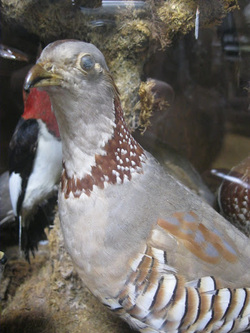
Case 5, Bird 2: The Barbary Partridge
The Barbary Partridge (Alectoris barbara), is a gamebird in the pheasant family Phasianidae of the order Galliformes, gallinaceous birds.
This partridge has its main native range in North Africa, and is also native to Gibraltar and the Canary Islands (Ssp Alectoris barbara koenigi).It has been introduced to Portugal and Madeira, though there are no recent records of this species on the latter islands. It is also present in Sardinia. It is closely related to its western European equivalent, the Red-legged Partridge (Alectoris rufa).
This 33–36 cm bird is a resident breeder in dry, open and often hilly country. It nests in a scantily lined ground scrape laying 10-16 eggs. The Barbary Partridge takes a wide variety of seeds and some insect food.
The Barbary Partridge is a rotund bird, with a grey-brown back, grey breast and buff belly. The face is light grey with a broad reddish-brown gorget. It has rufous-streaked white flanks and red legs. When disturbed, it prefers to run rather than fly, but if necessary it flies a short distance on rounded wings.
It is similar to the Red-legged Partridge, but it has a different head and neck pattern. The song is a noisy tre-tre-tre-tre-tre-cheeche-tre-tre-tre.
The Barbary Partridge is the national bird of Gibraltar.(Wikipedia)
This partridge has its main native range in North Africa, and is also native to Gibraltar and the Canary Islands (Ssp Alectoris barbara koenigi).It has been introduced to Portugal and Madeira, though there are no recent records of this species on the latter islands. It is also present in Sardinia. It is closely related to its western European equivalent, the Red-legged Partridge (Alectoris rufa).
This 33–36 cm bird is a resident breeder in dry, open and often hilly country. It nests in a scantily lined ground scrape laying 10-16 eggs. The Barbary Partridge takes a wide variety of seeds and some insect food.
The Barbary Partridge is a rotund bird, with a grey-brown back, grey breast and buff belly. The face is light grey with a broad reddish-brown gorget. It has rufous-streaked white flanks and red legs. When disturbed, it prefers to run rather than fly, but if necessary it flies a short distance on rounded wings.
It is similar to the Red-legged Partridge, but it has a different head and neck pattern. The song is a noisy tre-tre-tre-tre-tre-cheeche-tre-tre-tre.
The Barbary Partridge is the national bird of Gibraltar.(Wikipedia)
Western Meadowlark
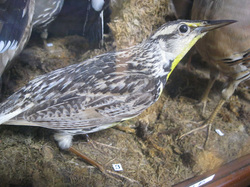
Case 5, Bird 3: The Western Meadowlark
Western Meadowlark (Sturnella neglecta) is a medium-sized blackbird, very similar in appearance to the Eastern Meadowlark. Adults have yellow underparts, with a black “V” on the breast, and white flanks which are streaked with black. Their upper parts are mostly brown, but also have black streaks. These birds have long pointed bills and their heads are striped with light brown and black.Their breeding habitats are grasslands, prairies, pastures, and abandoned fields, all of which may be found from across western and central North America to northern Mexico. Where their range overlaps with the eastern species, these birds prefer thinner, drier vegetation; the two types of birds generally do not interbreed but do defend territory against one another. Their nests are situated on the ground, and are covered with a roof woven from grass. There may be more than one nesting female in a male’s territory. Their nests, with eggs and young in them, are sometimes destroyed by mowing operations. Western Meadowlarks will interbreed with Eastern Meadowlarks where their ranges overlap, although their offspring are infertile. Western Meadowlarks are permanent residents throughout much of their range. Northern birds may migrate to the southern parts of their range. Some birds also move east in the southern United States. These birds forage on the ground or in low to semi-low vegetation. They sometimes search for food by probing with their bills. They mainly eat insects, although they will devour seeds and berries. In winter, these birds often feed in flocks. These birds have a flute-like warbled song. These calls contrast with the simple, whistled call of the Eastern Meadowlark. These two species were considered to be the same species for some time; the western species, having been overlooked for some time, was given the species name neglecta. This is the state bird of Kansas, Montana, Nebraska, North Dakota, Oregon and Wyoming.(Wikipedia).
Red-headed Woodpecker
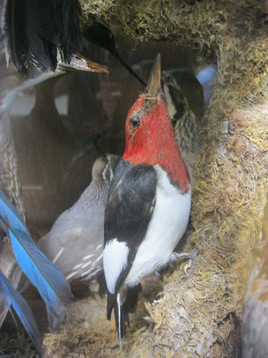
Case 5, Bird 4: The Red-headed Woodpecker
The Red-headed Woodpecker, Melanerpes erythrocephalus, is a small or medium-sized woodpecker from temperate North America. Their breeding habitat is open country across southern Canada and the eastern-central United States. These birds fly to catch insects in the air or on the ground, forage on trees or gather and store nuts. They are omnivorous, eating insects, seeds, fruits, berries, nuts, and occasionally even the eggs of other birds. About two thirds of their diet is made up of plants. They nest in a cavity in a dead tree, utility pole, or a dead part of a tree that is between 8 and 80 feet (2.5 to 25 m) above the ground. They lay four to seven eggs in early May which are incubated for two weeks. Two broods can be raised in a single nesting season. Northern birds migrate to the southern parts of the range, with most having arrived on the breeding range by late April, and having left for winter quarters by late October; southern birds are often permanent residents.
Once abundant, populations have seriously declined since 1966 due to increased nest site competition from European Starlings and removal of dead trees (used as nesting sites) from woodlands. Many Northeastern states no longer have nesting red-headed woodpeckers. In Ohio, for example, an irregular population is present in most years, but it is not self-sustaining.
The red-headed woodpecker is listed as a vulnerable species in Canada and as a threatened species in some states in the US. The species has declined in numbers due to habitat loss caused by harvesting of snags, agricultural development, channeling of rivers, a decline in farming resulting to regeneration of eastern forests, monoculture crops, the loss of small orchards, and treatment of telephone poles with creosote.
Once abundant, populations have seriously declined since 1966 due to increased nest site competition from European Starlings and removal of dead trees (used as nesting sites) from woodlands. Many Northeastern states no longer have nesting red-headed woodpeckers. In Ohio, for example, an irregular population is present in most years, but it is not self-sustaining.
The red-headed woodpecker is listed as a vulnerable species in Canada and as a threatened species in some states in the US. The species has declined in numbers due to habitat loss caused by harvesting of snags, agricultural development, channeling of rivers, a decline in farming resulting to regeneration of eastern forests, monoculture crops, the loss of small orchards, and treatment of telephone poles with creosote.
Rufus Motmot
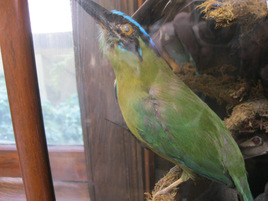
Case 5, Bird 5: The Rufus Motmot
Rufus Motmot (Baryphthengus martii) is a near-passerine bird which is a resident breeder in rain forests from northeastern Honduras south to western Ecuador, northeastern Bolivia, and southwestern Brazil.This large motmot is 46cm long and weighs 195 g. It is mainly cinnamon-rufous, with a black face mask and central breast spot, green wings and sides, a greenish-blue lower belly, and dark blue tail and flight feathers. The tail is very long and has a bare-shafted racket tip, except the Amazon. The bill and legs are black. Young birds are paler and duller than adults, and lack the tail rackets and black breast spot. The call of the Rufus Motmot is a low owl-like hoop hoop huhuhuhuhuhu. Rufus Motmots feed on insects, lizards, fish and crabs, and also take many fruits, especially those of palms and Heliconias. These birds often sit still on a canopy perch, and in their dense forest habitat can be difficult to see, despite their size and color.
Cock-of-the-Rock
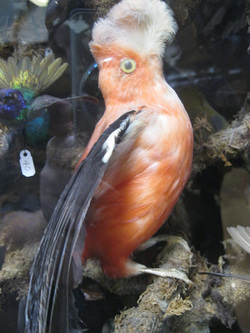
Case 5, Bird 6: The Cock-of-the-Rock
Cock-of-the-Rock (rupicola), the Andean Cock-of-the-rock is the national bird of Peru. They are found in tropical and subtropical rainforests close to rocky areas, where they build their nests. The males are magnificent birds, not only because of their bright orange or red colors, but also because of their very prominent fan-shaped crests. The far duller females are overall brownish. They are wary animals and primarily feed on fruits and berries. There are two species, the Andean Cock-of-the-rock (Rupicola peruviana) and the Guianan Cock-of-the-rock (Rupicola rupicola).(Wikipedia)
Bee-eater
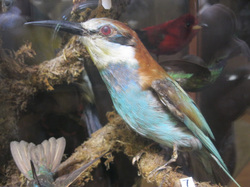
Case 5, Bird 7: The Bee-eater
The Bee-eaters are a group of near-passerine birds in the family Meropidae. Most species are found in Africa and Asia but others occur in southern Europe, Australia, and New Guinea. They are characterised by richly coloured plumage, slender bodies, and usually elongated central tail feathers. All have long downturned bills and pointed wings, which give them a swallow-like appearance when seen from afar. There are 26 different species of bee-eaters.
As the name suggests, Bee-eaters predominantly eat flying insects, especially bees and wasps, which are caught in the air by sallies from an open perch. While they pursue any type of flying insect, honey bees predominate in their diet. Hymenoptera (ants, bees and wasps) comprise from 20% to 96% of all insects eaten, with honey bees comprising approximately one-third of the Hymenoptera.
Before eating its meal, a bee-eater removes the stinger by repeatedly hitting and rubbing the insect on a hard surface. During this process, pressure is applied to the insect thereby extracting most of the venom. Notably, the birds only catch prey that are on the wing and ignore flying insects once they land.
Bee-eaters are gregarious. They form colonies by nesting in burrows tunnelled into the side of sandy banks, such as those that have collapsed on the edges of rivers. Their eggs are white and they generally produce 2-9 eggs per clutch (depending on species). As they live in colonies, large numbers of these holes are often seen together, white streaks from their accumulated droppings accentuating the entrances to the nests. Most of the species in the family are monogamous, and both parents care for the young, sometimes with the assistance of other birds in the colony, a behavior considered unusual for birds.Bee-eaters are fairly catholic in their habitat. Their requirements are simply an elevated perch from which to watch for prey and a ground substrate in which to dig their breeding burrow. Because their prey is entirely caught on the wing they are not dependent on any vegetation type. A single species is found inside closed rainforest, the Blue-headed Bee-eater, where it forages close to the ground in poor light in the gaps between large trees under the canopy. Six other species are also closely associated with rainforest, but do so in edge habitat in this environment; along rivers, in tree-fall gaps, off trees overhanging ravines or on emergent crowns above the main canopy.
A number of the bee-eaters are migratory. Species that breed in subtropical or temperate areas of Europe, Asia and Australia are all migrants. The European Bee-eaters that breed in southern Europe and Asia migrate to West and Southern Africa. Another population of the same species breeds in South Africa and Namibia; these birds move northwards after breeding. In Australia the Rainbow Bee-eater is migratory in the southern areas of its range, migrating to Indonesia and New Guinea, but occurs year round in northern Australia. Several species of bee-eater, such as the White-throated Bee-eater, are intra-African migrants. The most unusual migration is that of the Southern Carmine Bee-eater, which has a three stage migration; after breeding in a band between Angola and Mozambique it moves south to Botswana, Namibia and South Africa before moving north to its main wintering grounds in northern Angola, Congo and Tanzania.
The bee-eaters are diurnal (active by day), although a few species may migrate during the night if the terrain on route is unsuitable for stopping or if they are crossing the sea. They are a highly social family. Pairs sitting together are often so close together that they touch (described as having an individual distance of zero). Groups may roost together in a row in such a fashion as well. Some species are highly gregarious in the non-breeding season, and many species are colonial in the breeding season as well.
The social structures of the Red-throated Bee-eater and the White-fronted Bee-eaters have been described as “the most complex of any bird species anywhere in the world”. The birds exist in stable colonies located on nesting cliffs, and have a stable structure year round. These colonies are composed of clans of two or three pairs, their helpers, and offspring. Within the colony the males alternate between guarding their mate and attempting to make forced copulations other females.The females in turn attempt to lay eggs in their neighbour’s nests. Within colonies some individuals also specialise in kleptoparasitism, stealing prey collected by other colony members. The colony’s daily routine is emerge from the nesting holes or roosting branches soon after dawn, preen and sun themselves for an hour, then disperse to feed. Feeding territories are broken down by clan, with the clan defending the territories from all others of the same species, including clans of the same colony. The clans return to the colony before dusk, and engage in more social behaviour before retiring for the night. Colonies are situated several hundred metres apart and have little to do with each other, although young individuals may disperse between colonies. As such these species can be thought to have four tiers of social kinship, the individual pair, the family unit, the clan and the colony as a whole.
Bee-eaters spend around 10% of their day on what are known as comfort activities. These include sunning themselves, dust bathing and water bathing. Sunning behaviour helps warm birds in the morning, reducing the need to use energy to raise the temperature. It also has a social aspect, as multiple birds adopt the same posture. Finally, it may help stimulate parasites in the feathers, making them easier to find and remove. Due to their hole-nesting bee-eaters accumulate a number of ectoparasites such as mites and flies. Together with sunning, bouts of dust bathing (or water bathing where available), as well as rigorous preening, keep the feathers and skin in good health. Bathing with water involves making shallow dives into a water body and then returning to a perch to preen.
The bee-eaters are almost exclusively aerial hunters of insect prey. Prey is caught either while in continuous flight or more commonly from an exposed perch where the bee-eater watches for prey. Smaller, rounder-winged bee-eaters typically hunt from branches and twigs closer to the ground, whereas the larger species hunt from tree tops or telegraph wires. One unusual technique often used by carmine bee-eaters is to ride the back of bustards. Prey can be spotted from a distance; European Bee-eaters are able to spot a bee 60 m away, and Blue-cheeked Bee-eaters have been observed flying out 100 m to catch large wasps. Prey is approached directly or from behind. Prey that lands on the ground or on plants is usually not pursued. Small prey may be eaten on the wing, but larger prey are returned to the perch to be beaten against the perch to kill them and break them up. Insects with poisonous stings are first smacked on the branch, then, with the eyes closed, rubbed to discharge the venom. This behaviour is innate, as demonstrated by a juvenile bird in captivity, which performed the task when first presented with wild bees. This bird was stung on the first five tries, but by ten bees, it was as adept at handling bees as adult birds.
Bee-eaters are seasonally monogamous, and some species are monogamous over multiple seasons. Migratory species however are thought to form new pair bonds each breeding season. The courtship displays of the bee-eaters are rather unspectacular, with the exception of the “butterfly display” (where the wings of both sexes are held out while calling) of the White-throated Bee-eater. Most members of the family engage in courtship feeding, where the male presents prey items to the female, and such feeding can account for much if not all of the energy females require for egg creation.
Like almost all Coraciiformes the bee-eaters are cavity nesters.In the case of the bee-eaters the nests are burrows dug into the ground, either into the sides of earth cliffs or directly into level ground. Both types of nesting site are vulnerable, those on level ground are vulnerable to trampling and small predators, whereas those in cliffs, which are often the banks of rivers, are vulnerable to flash floods, which can wipe out dozens or hundreds of nests. Many species nest either on cliffs or on level ground but prefer cliffs, however the Böhm’s Bee-eater always nests on level ground. The burrows are dug by both birds in the pair as well as any helpers that have joined the pair. The soil or sand is loosened with jabs of the sharp bill, then the feet are used to kick out the loose substrate. There may be several false starts where nests are dug partway before being abandoned; in solitary species this can give the impression of colonial living even when they are not. The process of nest building can take as long as twenty days to complete, during which the bill can be both blunted and shortened. Nests are generally used only for a single season and are rarely used twice by the bee-eaters, but abandoned bee-eater nests may be used by a host of birds, snakes and bats as shelter and breeding places.
Bee-eaters may nest as single pairs, loose colonies or dense colonies. Smaller species tend to nest solitarily, while medium sized species do so in the smaller colonies and larger and migratory species nest in large colonies that can number in the thousands. In some instances colonies may contain more than one species of bee-eater. (Wikipedia)
As the name suggests, Bee-eaters predominantly eat flying insects, especially bees and wasps, which are caught in the air by sallies from an open perch. While they pursue any type of flying insect, honey bees predominate in their diet. Hymenoptera (ants, bees and wasps) comprise from 20% to 96% of all insects eaten, with honey bees comprising approximately one-third of the Hymenoptera.
Before eating its meal, a bee-eater removes the stinger by repeatedly hitting and rubbing the insect on a hard surface. During this process, pressure is applied to the insect thereby extracting most of the venom. Notably, the birds only catch prey that are on the wing and ignore flying insects once they land.
Bee-eaters are gregarious. They form colonies by nesting in burrows tunnelled into the side of sandy banks, such as those that have collapsed on the edges of rivers. Their eggs are white and they generally produce 2-9 eggs per clutch (depending on species). As they live in colonies, large numbers of these holes are often seen together, white streaks from their accumulated droppings accentuating the entrances to the nests. Most of the species in the family are monogamous, and both parents care for the young, sometimes with the assistance of other birds in the colony, a behavior considered unusual for birds.Bee-eaters are fairly catholic in their habitat. Their requirements are simply an elevated perch from which to watch for prey and a ground substrate in which to dig their breeding burrow. Because their prey is entirely caught on the wing they are not dependent on any vegetation type. A single species is found inside closed rainforest, the Blue-headed Bee-eater, where it forages close to the ground in poor light in the gaps between large trees under the canopy. Six other species are also closely associated with rainforest, but do so in edge habitat in this environment; along rivers, in tree-fall gaps, off trees overhanging ravines or on emergent crowns above the main canopy.
A number of the bee-eaters are migratory. Species that breed in subtropical or temperate areas of Europe, Asia and Australia are all migrants. The European Bee-eaters that breed in southern Europe and Asia migrate to West and Southern Africa. Another population of the same species breeds in South Africa and Namibia; these birds move northwards after breeding. In Australia the Rainbow Bee-eater is migratory in the southern areas of its range, migrating to Indonesia and New Guinea, but occurs year round in northern Australia. Several species of bee-eater, such as the White-throated Bee-eater, are intra-African migrants. The most unusual migration is that of the Southern Carmine Bee-eater, which has a three stage migration; after breeding in a band between Angola and Mozambique it moves south to Botswana, Namibia and South Africa before moving north to its main wintering grounds in northern Angola, Congo and Tanzania.
The bee-eaters are diurnal (active by day), although a few species may migrate during the night if the terrain on route is unsuitable for stopping or if they are crossing the sea. They are a highly social family. Pairs sitting together are often so close together that they touch (described as having an individual distance of zero). Groups may roost together in a row in such a fashion as well. Some species are highly gregarious in the non-breeding season, and many species are colonial in the breeding season as well.
The social structures of the Red-throated Bee-eater and the White-fronted Bee-eaters have been described as “the most complex of any bird species anywhere in the world”. The birds exist in stable colonies located on nesting cliffs, and have a stable structure year round. These colonies are composed of clans of two or three pairs, their helpers, and offspring. Within the colony the males alternate between guarding their mate and attempting to make forced copulations other females.The females in turn attempt to lay eggs in their neighbour’s nests. Within colonies some individuals also specialise in kleptoparasitism, stealing prey collected by other colony members. The colony’s daily routine is emerge from the nesting holes or roosting branches soon after dawn, preen and sun themselves for an hour, then disperse to feed. Feeding territories are broken down by clan, with the clan defending the territories from all others of the same species, including clans of the same colony. The clans return to the colony before dusk, and engage in more social behaviour before retiring for the night. Colonies are situated several hundred metres apart and have little to do with each other, although young individuals may disperse between colonies. As such these species can be thought to have four tiers of social kinship, the individual pair, the family unit, the clan and the colony as a whole.
Bee-eaters spend around 10% of their day on what are known as comfort activities. These include sunning themselves, dust bathing and water bathing. Sunning behaviour helps warm birds in the morning, reducing the need to use energy to raise the temperature. It also has a social aspect, as multiple birds adopt the same posture. Finally, it may help stimulate parasites in the feathers, making them easier to find and remove. Due to their hole-nesting bee-eaters accumulate a number of ectoparasites such as mites and flies. Together with sunning, bouts of dust bathing (or water bathing where available), as well as rigorous preening, keep the feathers and skin in good health. Bathing with water involves making shallow dives into a water body and then returning to a perch to preen.
The bee-eaters are almost exclusively aerial hunters of insect prey. Prey is caught either while in continuous flight or more commonly from an exposed perch where the bee-eater watches for prey. Smaller, rounder-winged bee-eaters typically hunt from branches and twigs closer to the ground, whereas the larger species hunt from tree tops or telegraph wires. One unusual technique often used by carmine bee-eaters is to ride the back of bustards. Prey can be spotted from a distance; European Bee-eaters are able to spot a bee 60 m away, and Blue-cheeked Bee-eaters have been observed flying out 100 m to catch large wasps. Prey is approached directly or from behind. Prey that lands on the ground or on plants is usually not pursued. Small prey may be eaten on the wing, but larger prey are returned to the perch to be beaten against the perch to kill them and break them up. Insects with poisonous stings are first smacked on the branch, then, with the eyes closed, rubbed to discharge the venom. This behaviour is innate, as demonstrated by a juvenile bird in captivity, which performed the task when first presented with wild bees. This bird was stung on the first five tries, but by ten bees, it was as adept at handling bees as adult birds.
Bee-eaters are seasonally monogamous, and some species are monogamous over multiple seasons. Migratory species however are thought to form new pair bonds each breeding season. The courtship displays of the bee-eaters are rather unspectacular, with the exception of the “butterfly display” (where the wings of both sexes are held out while calling) of the White-throated Bee-eater. Most members of the family engage in courtship feeding, where the male presents prey items to the female, and such feeding can account for much if not all of the energy females require for egg creation.
Like almost all Coraciiformes the bee-eaters are cavity nesters.In the case of the bee-eaters the nests are burrows dug into the ground, either into the sides of earth cliffs or directly into level ground. Both types of nesting site are vulnerable, those on level ground are vulnerable to trampling and small predators, whereas those in cliffs, which are often the banks of rivers, are vulnerable to flash floods, which can wipe out dozens or hundreds of nests. Many species nest either on cliffs or on level ground but prefer cliffs, however the Böhm’s Bee-eater always nests on level ground. The burrows are dug by both birds in the pair as well as any helpers that have joined the pair. The soil or sand is loosened with jabs of the sharp bill, then the feet are used to kick out the loose substrate. There may be several false starts where nests are dug partway before being abandoned; in solitary species this can give the impression of colonial living even when they are not. The process of nest building can take as long as twenty days to complete, during which the bill can be both blunted and shortened. Nests are generally used only for a single season and are rarely used twice by the bee-eaters, but abandoned bee-eater nests may be used by a host of birds, snakes and bats as shelter and breeding places.
Bee-eaters may nest as single pairs, loose colonies or dense colonies. Smaller species tend to nest solitarily, while medium sized species do so in the smaller colonies and larger and migratory species nest in large colonies that can number in the thousands. In some instances colonies may contain more than one species of bee-eater. (Wikipedia)
Starling
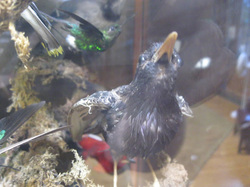
Case 5, Bird 8: The Starling
The Starling is among the most familiar of birds in temperate regions. It is 19–22 cm long, with a wingspan of 37–42 cm and a weight of 60–90 g. The plumage is shiny black, glossed purple or green, and spangled with white, particularly strongly so in winter. Adult male European Starlings are less spotted underneath than adult females. The throat feathers are long and loose, and used as a signal in display. Juveniles are grey-brown, and by their first winter resemble adults though often retain some brown juvenile feathering especially on the head in the early part of the winter. The legs are stout, pinkish-red. The bill is narrow conical with a sharp tip; in summer, it is yellow in females, and yellow with a blue-grey base in males, while in winter, and in juveniles, it is black in both sexes. Molting occurs once a year, in late summer after the breeding season is finished. The fresh feathers are prominently tipped white (breast feathers) or buff (wing and back feathers). The reduction in the spotting in the breeding season is achieved by the white feather tips largely wearing off. Starlings walk rather than hop. Their flight is quite strong and direct; they look triangular-winged and short-tailed in flight.
Eurasian Jay
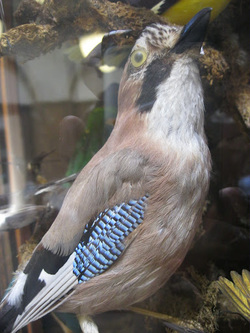
Case 5, Bird 9: The Eurasian Jay
The Eurasian Jay (Garrulus glandarius) is a species of bird occurring over a vast region from Western Europe and north-west Africa to the Indian Subcontinent and further to the eastern seaboard of Asia and down into south-east Asia. Across its vast range, several very distinct racial forms have evolved to look very different from each other, especially when forms at the extremes of its range are compared.
The bird is called jay, without any epithets, by English speakers in Britain and Ireland. Its usual call is the alarm call which is a harsh, rasping screech and is used upon sighting various predatory animals, but the Jay is well known for its mimicry, often sounding so like a different species that it is virtually impossible to distinguish its true identity unless the Jay is seen. It will even imitate the sound of the bird it is attacking, such as a Tawny Owl, which it does mercilessly if attacking during the day. However, the Jay is a potential prey item for owls at night and other birds of prey such as Goshawks and Peregrines during the day.
Feeding in both trees and on the ground, it takes a wide range of invertebrates including many pest insects, acorns (oak seeds, which it buries for use during winter), beech mast and other seeds, fruits such as blackberries and rowan berries, young birds and eggs and small rodents.
It nests in trees or large shrubs laying usually 4–6 eggs that hatch after 16–19 days and are fledged generally after 21–23 days. Both sexes typically feed the young.
The bird is called jay, without any epithets, by English speakers in Britain and Ireland. Its usual call is the alarm call which is a harsh, rasping screech and is used upon sighting various predatory animals, but the Jay is well known for its mimicry, often sounding so like a different species that it is virtually impossible to distinguish its true identity unless the Jay is seen. It will even imitate the sound of the bird it is attacking, such as a Tawny Owl, which it does mercilessly if attacking during the day. However, the Jay is a potential prey item for owls at night and other birds of prey such as Goshawks and Peregrines during the day.
Feeding in both trees and on the ground, it takes a wide range of invertebrates including many pest insects, acorns (oak seeds, which it buries for use during winter), beech mast and other seeds, fruits such as blackberries and rowan berries, young birds and eggs and small rodents.
It nests in trees or large shrubs laying usually 4–6 eggs that hatch after 16–19 days and are fledged generally after 21–23 days. Both sexes typically feed the young.
Rose-breasted Grosbeak
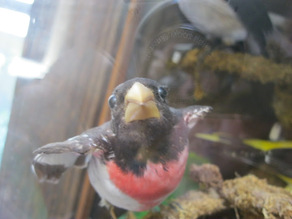
Case 5, Bird 10: The Rose-breasted Grosbeak
The Rose-breasted Grosbeak, Pheucticus ludovicianus, is a large seed-eating songbird in the cardinal family (Cardinalidae). It breeds in cool-temperate North America, migrating to tropical America in winter.
The Rose-breasted Grosbeak’s breeding habitat is open deciduous woods across most of Canada and the northeastern USA. In particular the northern birds migrate south through the United States east of the Rocky Mountains, to winter from central-southern Mexico through Central America and the Caribbean to Peru and Venezuela. In winter, they prefer more open woodland, or similar habitat with a loose growth of trees, such as forest edges, parks, gardens and plantations, ranging from sea level into the hills, e.g. up to 5,000 ft (1,500 m) ASL in Costa Rica.
The first birds leave the breeding grounds as early as August, while the last ones do not return until mid-late May. In general, however, they migrate south in late September or in October, and return in late April or early May. It appears as if they remain on their breeding grounds longer today than they did in the early 20th century, when migrants were more commonly seen in May and August than in April or September.
It builds a twig nest in a tree or large shrub. The Rose-breasted Grosbeak forages in shrubs or trees for insects, seeds and berries, also catching insects in flight and occasionally eating nectar. It usually keeps to the treetops, and only rarely can be seen on the ground. During breeding it is fairly territorial; in winter, it roams the lands in groups of about a handful of birds, and sometimes in larger flocks of a dozen or more. In the winter quarters, they can be attracted into parks, gardens, and possibly even to bird feeders by fruit like Trophis racemosa. Other notable winter food includes Jacaranda seeds and the fruits of the introduced Busy Lizzy (Impatiens walleriana).
Fire prevention policies in the late 20th century have allowed forests to spread on the Great Plains in places where they would otherwise eventually burn down, thereby allowing the Rose-breasted Grosbeak to extend its range westwards. Increased hybridization with the Black-headed Grosbeak subspecies P. melanocephalus papagohas been recorded as a consequence. Indeed, range expansions seem also to have occurred elsewhere, for example in northern Ohio where it bred rarely if at all in the 1900s, but it by no means an uncommon breeder today. In general, though it requires mature woodland to breed and is occasionally caught as a cage bird,. The Rose-breasted Grosbeak is not at all rare, and not considered a threatened species by the IUCN. (Wikipedia)
The Rose-breasted Grosbeak’s breeding habitat is open deciduous woods across most of Canada and the northeastern USA. In particular the northern birds migrate south through the United States east of the Rocky Mountains, to winter from central-southern Mexico through Central America and the Caribbean to Peru and Venezuela. In winter, they prefer more open woodland, or similar habitat with a loose growth of trees, such as forest edges, parks, gardens and plantations, ranging from sea level into the hills, e.g. up to 5,000 ft (1,500 m) ASL in Costa Rica.
The first birds leave the breeding grounds as early as August, while the last ones do not return until mid-late May. In general, however, they migrate south in late September or in October, and return in late April or early May. It appears as if they remain on their breeding grounds longer today than they did in the early 20th century, when migrants were more commonly seen in May and August than in April or September.
It builds a twig nest in a tree or large shrub. The Rose-breasted Grosbeak forages in shrubs or trees for insects, seeds and berries, also catching insects in flight and occasionally eating nectar. It usually keeps to the treetops, and only rarely can be seen on the ground. During breeding it is fairly territorial; in winter, it roams the lands in groups of about a handful of birds, and sometimes in larger flocks of a dozen or more. In the winter quarters, they can be attracted into parks, gardens, and possibly even to bird feeders by fruit like Trophis racemosa. Other notable winter food includes Jacaranda seeds and the fruits of the introduced Busy Lizzy (Impatiens walleriana).
Fire prevention policies in the late 20th century have allowed forests to spread on the Great Plains in places where they would otherwise eventually burn down, thereby allowing the Rose-breasted Grosbeak to extend its range westwards. Increased hybridization with the Black-headed Grosbeak subspecies P. melanocephalus papagohas been recorded as a consequence. Indeed, range expansions seem also to have occurred elsewhere, for example in northern Ohio where it bred rarely if at all in the 1900s, but it by no means an uncommon breeder today. In general, though it requires mature woodland to breed and is occasionally caught as a cage bird,. The Rose-breasted Grosbeak is not at all rare, and not considered a threatened species by the IUCN. (Wikipedia)
Sunbird

Case 5, Bird 11: The Sunbird
The sunbirds and spiderhunters are a family, Nectariniidae, of very small passerine birds. There are 132 species in 15 genera. The family is distributed throughout Africa, the Indian Subcontinent, Southeast Asia and just reaches northern Australia. Most sunbirds feed largely on nectar, but also take insects and spiders, especially when feeding young. Flower tubes that bar access to nectar because of their shape, are simply punctured at the base near the nectaries. Fruit is also part of the diet of some species. Their flight is fast and direct on their short wings.
The sunbirds have counterparts in two very distantly related groups: the hummingbirds of the Americas and the honeyeaters of Australia. The resemblances are due to convergent evolution brought about by a similar nectar-feeding lifestyle. Some sunbird species can take nectar by hovering like a hummingbird, but usually perch to feed.
Sunbirds are a tropical Old World family, with representatives in Africa, Asia and Australasia. In Africa they are found mostly in sub-Saharan Africa and Madagascar but are also distributed in Egypt. In Asia the group occurs along the coasts of the Red Sea as far north as Israel, with a gap in their distribution till Iran, from where the group occurs continuously as far as southern China and Indonesia. In Australasia the family occurs in New Guinea, north eastern Australia and the Solomon Islands. They are generally not found on oceanic islands, with the exception of the Seychelles. The greatest variety of species is found in Africa, where the group probably arose. Most species are sedentary or short-distance seasonal migrants. Sunbirds occur over the entire family’s range, whereas the spiderhunters are restricted to Asia.
The sunbirds and spiderhunters occupy a wide range of habitats, with a majority of species being found in primary rainforest, but other habitats used by the family including disturbed secondary forest, open woodland, open scrub and savannah, coastal scrub and alpine forest. Some species have readily adapted to human modified landscapes such as plantations, gardens and agricultural land. Many species are able to occupy a wide range of habitats from sea level to 4900 m.
Sunbird are active diurnal birds that generally occur in pairs or occasionally in small family groups. A few species occasionally gather in larger groups, and sunbird will join with other birds to mob potential predators, although sunbirds will also aggressively target other species, even if they are not predators, when defending their territories.
The sunbirds that breed outside of the equatorial regions are mostly seasonal breeders, with the majority of these species breeding in the wet season. This timing reflects the increased availability of insect prey for the growing young. Where species, like the Buff-throated Sunbird, breed in the dry season, it is thought to be associated with the flowering of favoured food plants. Species of sunbird in the equatorial areas breed throughout the year. They are generally monogamous and often territorial, although a few species of sunbirds have lekking behaviour.
The nests of sunbirds are generally purse-shaped, enclosed, suspended from thin branches with generous use of spiderweb. The nests of the spiderhunters are different, both from the sunbirds and in some cases from each other. Some, like the Little Spiderhunter, are small woven cups attached to the underside of large leaves; that of the Yellow-eared Spiderhunter is similarly attached but is a long tube. The nests of spiderhunters are inconspicuous, in contrast to those of the other sunbirds which are more visible. In most species the female alone constructs the nest. Up to four eggs are laid. The female builds the nest and incubates the eggs alone, although the male assists in rearing the nestlings. In the spiderhunters both sexes help to incubate the eggs. The nests of sunbirds and spiderhunters are often targeted by brood parasites such as cuckoos and honeyguides.
Overall the family has fared better than many others, with only seven species considered to be threatened with extinction. Most species are fairly resistant to changes in habitat, and while attractive the family is not sought after by the cagebird trade, as they have what is considered an unpleasant song and are tricky to keep alive. Sunbirds are considered attractive birds and readily enter gardens where flowering plants are planted to attract them. There are a few negative interactions, for example the Scarlet-chested Sunbird is considered a pest in cocoa plantations as it spreads parasitic mistletoes.
The sunbirds have counterparts in two very distantly related groups: the hummingbirds of the Americas and the honeyeaters of Australia. The resemblances are due to convergent evolution brought about by a similar nectar-feeding lifestyle. Some sunbird species can take nectar by hovering like a hummingbird, but usually perch to feed.
Sunbirds are a tropical Old World family, with representatives in Africa, Asia and Australasia. In Africa they are found mostly in sub-Saharan Africa and Madagascar but are also distributed in Egypt. In Asia the group occurs along the coasts of the Red Sea as far north as Israel, with a gap in their distribution till Iran, from where the group occurs continuously as far as southern China and Indonesia. In Australasia the family occurs in New Guinea, north eastern Australia and the Solomon Islands. They are generally not found on oceanic islands, with the exception of the Seychelles. The greatest variety of species is found in Africa, where the group probably arose. Most species are sedentary or short-distance seasonal migrants. Sunbirds occur over the entire family’s range, whereas the spiderhunters are restricted to Asia.
The sunbirds and spiderhunters occupy a wide range of habitats, with a majority of species being found in primary rainforest, but other habitats used by the family including disturbed secondary forest, open woodland, open scrub and savannah, coastal scrub and alpine forest. Some species have readily adapted to human modified landscapes such as plantations, gardens and agricultural land. Many species are able to occupy a wide range of habitats from sea level to 4900 m.
Sunbird are active diurnal birds that generally occur in pairs or occasionally in small family groups. A few species occasionally gather in larger groups, and sunbird will join with other birds to mob potential predators, although sunbirds will also aggressively target other species, even if they are not predators, when defending their territories.
The sunbirds that breed outside of the equatorial regions are mostly seasonal breeders, with the majority of these species breeding in the wet season. This timing reflects the increased availability of insect prey for the growing young. Where species, like the Buff-throated Sunbird, breed in the dry season, it is thought to be associated with the flowering of favoured food plants. Species of sunbird in the equatorial areas breed throughout the year. They are generally monogamous and often territorial, although a few species of sunbirds have lekking behaviour.
The nests of sunbirds are generally purse-shaped, enclosed, suspended from thin branches with generous use of spiderweb. The nests of the spiderhunters are different, both from the sunbirds and in some cases from each other. Some, like the Little Spiderhunter, are small woven cups attached to the underside of large leaves; that of the Yellow-eared Spiderhunter is similarly attached but is a long tube. The nests of spiderhunters are inconspicuous, in contrast to those of the other sunbirds which are more visible. In most species the female alone constructs the nest. Up to four eggs are laid. The female builds the nest and incubates the eggs alone, although the male assists in rearing the nestlings. In the spiderhunters both sexes help to incubate the eggs. The nests of sunbirds and spiderhunters are often targeted by brood parasites such as cuckoos and honeyguides.
Overall the family has fared better than many others, with only seven species considered to be threatened with extinction. Most species are fairly resistant to changes in habitat, and while attractive the family is not sought after by the cagebird trade, as they have what is considered an unpleasant song and are tricky to keep alive. Sunbirds are considered attractive birds and readily enter gardens where flowering plants are planted to attract them. There are a few negative interactions, for example the Scarlet-chested Sunbird is considered a pest in cocoa plantations as it spreads parasitic mistletoes.
Snow Bunting
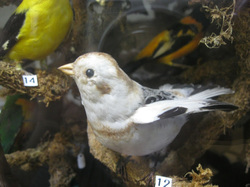
Case 5, Bird 12:
The Snow Bunting (Plectrophenax nivalis), sometimes colloquially called a snowflake, is a passerine bird in the longspur family Calcariidae. It is an arctic specialist, with a circumpolar Arctic breeding range throughout the northern hemisphere. There are small isolated populations on a few high mountain tops south of the Arctic region, including the Cairngorms in central Scotland and the Saint Elias Mountains on the southern Alaska-Yukon border, and also Cape Breton Highlands.
It is fairly large and long-winged for a bunting, 15–18 cm long and with a wingspan of 32–38 cm, and weighing 26–50 g. In flight, it is easily identified by its large white wing patches. The breeding male is unmistakable, with all white plumage and a black back; the breeding female is grey-black where the male is solid black. In winter plumage, both sexes are mottled pale ginger, blackish and white above, and pale ginger and white below, with the males having more white than the females. The bill is yellow with a black tip, all black in summer males. Unlike most passerines, it has feathered tarsi, an adaptation to its harsh environment. No other passerine can winter as far north as this species apart from the Common Raven.
The call is a distinctive rippling whistle, “per,r,r,rit” and the typical Plectrophenax warble “hudidi feet feet feew hudidi”.
It builds its bulky nest in rock crevices. The eggs are blue-green, spotted brown, and hatch in 12–13 days, and the young are already ready to fly after a further 12–14 days.
The breeding habitat is on tundra, treeless moors, and bare mountains. It is migratory, wintering a short distance further south in open habitats in northern temperate areas, typically on either sandy coasts, steppes, prairies, or low mountains, more rarely on farmland stubble. In winter, it forms mobile flocks. During the last ice age, the Snow Bunting was widespread throughout continental Europe. (Wikipedia)
It is fairly large and long-winged for a bunting, 15–18 cm long and with a wingspan of 32–38 cm, and weighing 26–50 g. In flight, it is easily identified by its large white wing patches. The breeding male is unmistakable, with all white plumage and a black back; the breeding female is grey-black where the male is solid black. In winter plumage, both sexes are mottled pale ginger, blackish and white above, and pale ginger and white below, with the males having more white than the females. The bill is yellow with a black tip, all black in summer males. Unlike most passerines, it has feathered tarsi, an adaptation to its harsh environment. No other passerine can winter as far north as this species apart from the Common Raven.
The call is a distinctive rippling whistle, “per,r,r,rit” and the typical Plectrophenax warble “hudidi feet feet feew hudidi”.
It builds its bulky nest in rock crevices. The eggs are blue-green, spotted brown, and hatch in 12–13 days, and the young are already ready to fly after a further 12–14 days.
The breeding habitat is on tundra, treeless moors, and bare mountains. It is migratory, wintering a short distance further south in open habitats in northern temperate areas, typically on either sandy coasts, steppes, prairies, or low mountains, more rarely on farmland stubble. In winter, it forms mobile flocks. During the last ice age, the Snow Bunting was widespread throughout continental Europe. (Wikipedia)
Cedar Waxwings
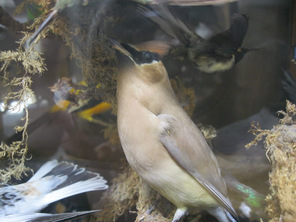
Case 5, Bird 13: The Cedar Waxwings
Cedar Waxwings are approximately 6-7” (15-18 cm) in length and weigh roughly 30 grams. They are smaller and browner than their close relative, the Bohemian Waxwing (which breeds further to the north and west). These birds’ most prominent feature is a small cluster of bright red feathers on the wings, a feature they share with the Bohemian Waxwing. The tail is typically yellow or orange depending on diet. Birds that have fed on berries of introduced Eurasian honeysuckles while growing tail feathers will have darker orange-tipped tail-feathers. Adults have a pale yellow belly. Immature birds are streaked on the throat and flanks, and often do not have the black mask of the adults. During courtship the male and female will sit together and pass small objects back and forth, such as flower petals or an insect. Mating pairs will sometimes rub their bills together affectionately. Cedar Waxwings eat berries and sugary fruit year-round, with insects becoming an important part of the diet in the breeding season.(Wikipedia)
Eurasian Golden Oriole
The Eurasian Golden Oriole or simply Golden Oriole (Oriolus oriolus) is the only member of the oriole family of passerine birds breeding in northern hemisphere temperate regions. It is a summer migrant in Europe and western Asia and spends the winter season in the central and southern Africa.
Golden orioles have an extremely large range with large populations that are apparently stable. Therefore, they are evaluated as least concern by BirdLife International. The male is striking in the typical oriole black and yellow plumage, but the female is a drabber green bird. Orioles are shy, and even the male is remarkably difficult to see in the dappled yellow and green leaves of the canopy. In flight they look somewhat like a thrush, strong and direct with some shallow dips over longer distances.
The breeding range of this species spans from Portugal, Spain and France across the United Kingdom and Scandinavia to Poland, Russia, the Balkans, Turkey and West Asia to the Caucasus up to Mongolia and China. They winter in central and southern Africa. They generally migrate during the night, but may travel during the day in the spring migration. During the fall migration they migrate via the Eastern Mediterranean where they feed on fruit; they are often considered a pest in this region because of this.
The Eurasian Golden Oriole inhabits a range of habitats. In Western Europe they prefer open broadleaf forests and plantations, copses, riverine forest, orchards, large gardens; in Eastern Europe they may inhabit more continuous forest as well as mixed or coniferous forests. They generally avoid treeless habitats but may forage there. In their wintering habitat they are fond in semi-arid to humid woodland, tall forests, riverine forest, woodland/savanna mosaic and savanna.
They feed on insects and fruit. They build neat nests in tree forks and lay 3-6 eggs.Their call is a screech like a jay, but the song is a beautiful fluting weela-wee-ooo or or-iii-ole, unmistakable once heard. Until a few years ago this species was treated as being conspecific with the Indian Golden Oriole.
The name “oriole” was first used in the 18th century and is an adaptation of the scientific Latin genus name, which is derived from the Classical Latin “aureolus” meaning golden. Various forms of “oriole” have existed in Roman languages since the 12th and 13th centuries. Albertus Magnus used the Latin form oriolus in about 1250 and erroneously stated that it was onomatopoeic because of the Golden Oriole’s song.
Golden orioles have an extremely large range with large populations that are apparently stable. Therefore, they are evaluated as least concern by BirdLife International. The male is striking in the typical oriole black and yellow plumage, but the female is a drabber green bird. Orioles are shy, and even the male is remarkably difficult to see in the dappled yellow and green leaves of the canopy. In flight they look somewhat like a thrush, strong and direct with some shallow dips over longer distances.
The breeding range of this species spans from Portugal, Spain and France across the United Kingdom and Scandinavia to Poland, Russia, the Balkans, Turkey and West Asia to the Caucasus up to Mongolia and China. They winter in central and southern Africa. They generally migrate during the night, but may travel during the day in the spring migration. During the fall migration they migrate via the Eastern Mediterranean where they feed on fruit; they are often considered a pest in this region because of this.
The Eurasian Golden Oriole inhabits a range of habitats. In Western Europe they prefer open broadleaf forests and plantations, copses, riverine forest, orchards, large gardens; in Eastern Europe they may inhabit more continuous forest as well as mixed or coniferous forests. They generally avoid treeless habitats but may forage there. In their wintering habitat they are fond in semi-arid to humid woodland, tall forests, riverine forest, woodland/savanna mosaic and savanna.
They feed on insects and fruit. They build neat nests in tree forks and lay 3-6 eggs.Their call is a screech like a jay, but the song is a beautiful fluting weela-wee-ooo or or-iii-ole, unmistakable once heard. Until a few years ago this species was treated as being conspecific with the Indian Golden Oriole.
The name “oriole” was first used in the 18th century and is an adaptation of the scientific Latin genus name, which is derived from the Classical Latin “aureolus” meaning golden. Various forms of “oriole” have existed in Roman languages since the 12th and 13th centuries. Albertus Magnus used the Latin form oriolus in about 1250 and erroneously stated that it was onomatopoeic because of the Golden Oriole’s song.
Rufus-tailed Jacamar
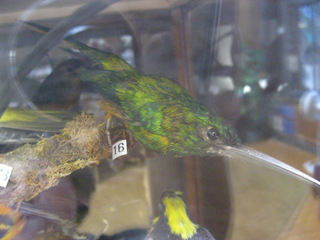
Case 5, Bird 16: The Rufus-tailed Jacamar
The Rufus-tailed Jacamar (galbula ruficauda) are elegant brightly colored birds with long bills and tails. The Rufus-tailed Jacamar is typically 25 cm long with a 5 cm long black bill. This bird is metallic green above, and the underparts are mainly orange, including the undertail, but there is a green breast band. Sexes differ in that the male has a white throat, and the female a buff throat; she also tends to have paler underparts. This species is a resident breeder in a range of dry or moist woodlands and scrub. The two to four rufous-spotted white eggs are laid in a burrow in a bank or termite mound. This insectivore hunts from a perch, sitting with its bill tilted up, then flying out to catch flying insects. The bird distinguishes between edible and unpalatable butterflies mainly according to body shape. The Rufous-tailed Jacamar’s call is a sharp pee-op, and the song a high thin peeo-pee-peeo-pee-pe-pe, ending in a trill.
Crimson-collared Tanager
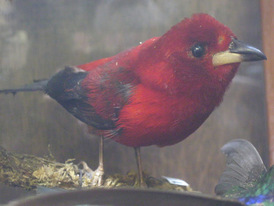
Case 5, Bird 17: The Crimson-collared Tanager
The Crimson-collared Tanager (Ramphocelus sanguinolentus) is a rather small Middle American songbird. It was first described by the French naturalist René-Primevère Lesson in 1831, its specific epithet from the Latin adjective sanguinolentus, “bloodied”, referring to its red plumage.
This species is sometimes placed in a genus of its own as Phlogothraupis sanguinolenta, and a genetic study suggests that it is less closely related to the other Ramphocelus tanagers than they are to each other. Its closest relative is the Masked Crimson Tanager.
Crimson-collared Tanagers average 19–20 cm (7.5–8 in long. The adult plumage is black with a red collar covering the nape, neck, and breast(remarkably similar to the pattern of the male Crimson-collared Grosbeak). All tail coverts are also red. The bill is striking pale blue and the legs are blue-gray. In adults, the irides are crimson, contrary to what is shown in Howell & Webb. Females average slightly duller than males, but are sometimes indistinguishable from them. Juvenile birds are similar except that the hood is dull red, the black areas are tinged with brown, and the breast is mottled red and black. Young birds also have a duller bill color.
Vocalizations are high-pitched and sibilant. There are several calls; one rendered as ssii-p is given both when perched and in flight. The song is jerky and consists of two-to-four-note phrases separated by pauses, tueee-teew, chu-chee-wee-chu, teweee.
The Crimson-collared Tanager ranges from southern Veracruz and northern Oaxaca in Mexico through the Atlantic slope of Central America, to the highlands of western Panama. It inhabits the edges of humid evergreen forests and second growth, where it is often seen in pairs at middle to upper levels.(Wikipedia)
This species is sometimes placed in a genus of its own as Phlogothraupis sanguinolenta, and a genetic study suggests that it is less closely related to the other Ramphocelus tanagers than they are to each other. Its closest relative is the Masked Crimson Tanager.
Crimson-collared Tanagers average 19–20 cm (7.5–8 in long. The adult plumage is black with a red collar covering the nape, neck, and breast(remarkably similar to the pattern of the male Crimson-collared Grosbeak). All tail coverts are also red. The bill is striking pale blue and the legs are blue-gray. In adults, the irides are crimson, contrary to what is shown in Howell & Webb. Females average slightly duller than males, but are sometimes indistinguishable from them. Juvenile birds are similar except that the hood is dull red, the black areas are tinged with brown, and the breast is mottled red and black. Young birds also have a duller bill color.
Vocalizations are high-pitched and sibilant. There are several calls; one rendered as ssii-p is given both when perched and in flight. The song is jerky and consists of two-to-four-note phrases separated by pauses, tueee-teew, chu-chee-wee-chu, teweee.
The Crimson-collared Tanager ranges from southern Veracruz and northern Oaxaca in Mexico through the Atlantic slope of Central America, to the highlands of western Panama. It inhabits the edges of humid evergreen forests and second growth, where it is often seen in pairs at middle to upper levels.(Wikipedia)
Blue Jay
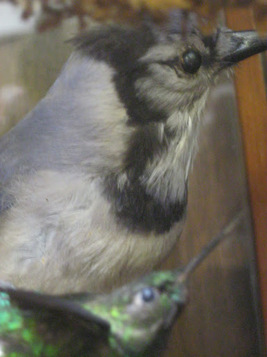
Case 5, Bird 18: The Blue Jay
The Blue Jay (Cyanocitta cristata) is a passerine bird in the family Corvidae, native to North America. It is resident through most of eastern and central United States and southern Canada, although western populations may be migratory. It breeds in both deciduous and coniferous forests, and is common near and in residential areas. It is predominately blue with a white chest and underparts, and a blue crest. It has a black, U-shaped collar around its neck and a black border behind the crest. Sexes are similar in size and plumage, and plumage does not vary throughout the year.
The Blue Jay mainly feeds on nuts and seeds such as acorns, soft fruits, arthropods, and occasionally small vertebrates. It typically gleans food from trees, shrubs, and the ground, though it sometimes hawks insects from the air. It builds an open cup nest in the branches of a tree, which both sexes participate in constructing. The clutch can contain two to seven eggs, which are blueish or light brown with brown spots. Young are altricial, and are brooded by the female for 8–12 days after hatching. They may remain with their parents for one to two months.
The bird’s name derives from its noisy, garrulous nature, and it sometimes also called a “jaybird”.
The Blue Jay occurs from southern Canada through the eastern and central USA south to Florida and northeastern Texas. The western edge of the range stops where the arid pine forest and scrub habitat of the closely related Steller’s jay (C. stelleri) begins. Recently, the range of the Blue Jay has extended northwestwards so that it is now a rare but regularly seen winter visitor along the northern US and southern Canadian Pacific Coast, as the two species’ ranges now overlap, C. cristata may sometimes hybridize with Steller’s jay.
The Blue Jay occupies a variety of habitats within its large range, from the pine woods of Florida to the spruce-fir forests of northern Ontario. It is less abundant in denser forests, preferring mixed woodlands with oaks and beeches. It has expertly adapted to human activity, occurring in parks and residential areas, and can adapt to wholesale deforestation with relative ease if human activity creates other means for the jays to get by.(Wikipedia)
The Blue Jay mainly feeds on nuts and seeds such as acorns, soft fruits, arthropods, and occasionally small vertebrates. It typically gleans food from trees, shrubs, and the ground, though it sometimes hawks insects from the air. It builds an open cup nest in the branches of a tree, which both sexes participate in constructing. The clutch can contain two to seven eggs, which are blueish or light brown with brown spots. Young are altricial, and are brooded by the female for 8–12 days after hatching. They may remain with their parents for one to two months.
The bird’s name derives from its noisy, garrulous nature, and it sometimes also called a “jaybird”.
The Blue Jay occurs from southern Canada through the eastern and central USA south to Florida and northeastern Texas. The western edge of the range stops where the arid pine forest and scrub habitat of the closely related Steller’s jay (C. stelleri) begins. Recently, the range of the Blue Jay has extended northwestwards so that it is now a rare but regularly seen winter visitor along the northern US and southern Canadian Pacific Coast, as the two species’ ranges now overlap, C. cristata may sometimes hybridize with Steller’s jay.
The Blue Jay occupies a variety of habitats within its large range, from the pine woods of Florida to the spruce-fir forests of northern Ontario. It is less abundant in denser forests, preferring mixed woodlands with oaks and beeches. It has expertly adapted to human activity, occurring in parks and residential areas, and can adapt to wholesale deforestation with relative ease if human activity creates other means for the jays to get by.(Wikipedia)
Blue-winged Mountain-Tanager
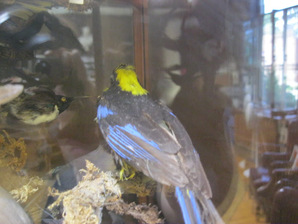
Case 5, Bird 19: The Blue-Winged Mountain-Tanager
The Blue-winged Mountain-tanager (Anisognathus somptuosus) is a species of bird in the Thraupidae family.
It is found in Bolivia, Colombia, Ecuador, Peru, and Venezuela. Its natural habitat is subtropical or tropical moist mountain forests. (Wikipedia)
It is found in Bolivia, Colombia, Ecuador, Peru, and Venezuela. Its natural habitat is subtropical or tropical moist mountain forests. (Wikipedia)
Red-legged Partridge
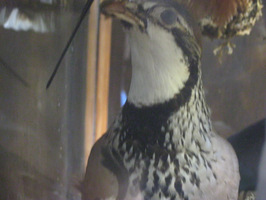
Case 5, Bird 21: The Red-legged Partridge
The Red-legged Partridge (Alectoris rufa) is a gamebird in the pheasant family Phasianidae of the order Galliformes, gallinaceous birds. It is sometimes known as French Partridge, to distinguish it from the Grey or English Partridge. It is a rotund bird, with a light brown back, grey breast and buff belly. The face is white with a black gorget. It has rufous-streaked flanks and red legs. When disturbed, it prefers to run rather than fly, but if necessary it flies a short distance on rounded wings .This is a seed-eating species, but the young in particular take insects as an essential protein supply. The call is a three-syllable ka-chu-chu.This partridge breeds naturally in south western Europe, in France and Iberia. It has become naturalized in flat areas of England and Wales, where it was introduced as a game species, and has been seen breeding as far North as Lancashire and Eastern Yorkshire and the western Isle of Man. It is replaced in south eastern Europe by the very similar Rock Partridge (Alectoris graeca). It is a non-migratory terrestrial species, which forms flocks outside the breeding season. This species breeds on dry lowlands, such as farmland and open stony areas, laying its eggs in a ground nest.
California Quail
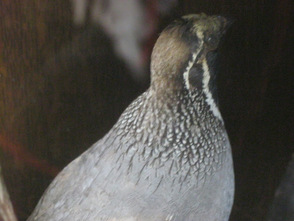
Case 5, Bird 22: The California Quail
The California Quail, Callipepla californica, also known as the California Valley Quail or Valley Quail, is a small ground-dwelling bird in the New World quail family. It is the state bird of California. The California Quail is a highly sociable bird that often gathers in small flocks known as “coveys”. One of their daily communal activities is a dust bath. A group of quail will select an area where the ground has been newly turned or is soft, and using their underbellies, will burrow downward into the soil some one to two inches. They then wriggle about in the indentations they have created, flapping their wings and ruffling their feathers, causing dust to rise in the air. They seem to prefer sunny places in which to create these dust baths. An ornithologist is able to detect the presence of quail in an area by spotting the circular indentations left behind in the soft dirt, some 7–15 cm (3-6 inches) in diameter.
They are year-round residents. Although this bird coexists well at the edges of urban areas, it is declining in some areas as human populations increase. They were originally found mainly in the southwestern United States but they have been introduced into other areas including British Columbia, Hawaii, Chile, New Zealand, and to Norfolk Island and King Island in Australia. These birds forage on the ground, often scratching at the soil. They can sometimes be seen feeding at the sides of roads. Their diet consists mainly of seeds and leaves, but they also eat some berries and insects; for example, Toyon berries are a common food source. If startled, these birds explode into short rapid flight, called “flushing”. Given a choice, they will normally escape on foot.
Their breeding habitat is shrubby areas and open woodlands in western North America. The nest is a shallow scrape lined with vegetation on the ground beneath a shrub or other cover. The female usually lays approximately twelve eggs. Once hatched, the young associate with both adults. Often, families group together, into multifamily “communal broods” which include at least two females, multiple males and many offspring. Males associated with families are not always the genetic fathers. In good years, females will lay more than one clutch, leaving the hatched young with the associated male and laying a new clutch, often with a different associated male.
They have a variety of vocalizations including the social “chicago” call, contact “pips” and warning “pips.” During the breeding season, males utter the agonistic “squill” and will often interrupt their social mate’s “chicago” call with a “squill,” a possible form of antiphonal calling. (Wikipedia)
They are year-round residents. Although this bird coexists well at the edges of urban areas, it is declining in some areas as human populations increase. They were originally found mainly in the southwestern United States but they have been introduced into other areas including British Columbia, Hawaii, Chile, New Zealand, and to Norfolk Island and King Island in Australia. These birds forage on the ground, often scratching at the soil. They can sometimes be seen feeding at the sides of roads. Their diet consists mainly of seeds and leaves, but they also eat some berries and insects; for example, Toyon berries are a common food source. If startled, these birds explode into short rapid flight, called “flushing”. Given a choice, they will normally escape on foot.
Their breeding habitat is shrubby areas and open woodlands in western North America. The nest is a shallow scrape lined with vegetation on the ground beneath a shrub or other cover. The female usually lays approximately twelve eggs. Once hatched, the young associate with both adults. Often, families group together, into multifamily “communal broods” which include at least two females, multiple males and many offspring. Males associated with families are not always the genetic fathers. In good years, females will lay more than one clutch, leaving the hatched young with the associated male and laying a new clutch, often with a different associated male.
They have a variety of vocalizations including the social “chicago” call, contact “pips” and warning “pips.” During the breeding season, males utter the agonistic “squill” and will often interrupt their social mate’s “chicago” call with a “squill,” a possible form of antiphonal calling. (Wikipedia)
Hawfinch
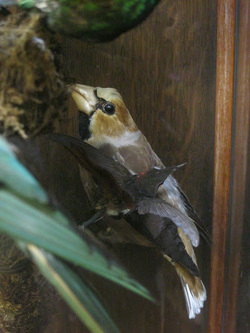
Case 5, Bird 24: The Hawfinch
The Hawfinch (coccothraustes) is a passerine bird in the finch family Fringillidae. As its closest living relatives are the Evening Grosbeak (C. vespertinus) from North America and the Hooded Grosbeak (C. abeillei) from Central America especially Mexico, the Hawfinch is sometimes also known as European Grosbeak. This bird breeds across Europe and temperate Asia. Deciduous or mixed woodland with large trees, especially Hornbeam, is favored for breeding, including parkland. It builds its nest in a bush or tree, laying 2-7 eggs. The food is mainly seeds and fruit kernels, especially those of cherries, which it cracks with its powerful bill. (Wikipedia)
Sacred Kingfisher
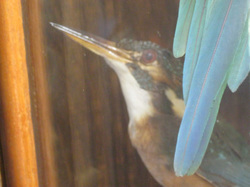
Case 5, Bird 26: The Sacred Kingfisher
The Sacred Kingfisher (Todiramphus sanctus) is a medium sized woodland kingfisher that occurs in mangroves, woodlands, forests, and river valleys in Australia, New Zealand, and other parts of the western Pacific. In New Zealand the species is also known by its Māori name Kōtare.Sacred Kingfishers are found in Australia, New Zealand, Lord Howe Island, Norfolk Island, New Guinea, eastern Indonesia, much of northern and western Melanesia, and the Kermadec Islands. This species breeds throughout much of Australia (except the dry interior), New Zealand, New Caledonia and locally, New Guinea. Populations in the southern two-thirds of Australia migrate northwards at the end of breeding season to New Guinea, east to the eastern Solomon Islands and west to Indonesia becoming uncommon to very sparse as west as Sumatra. Birds move south again to Australia in August to September. It has also occurred as a vagrant on Christmas Island (in the Indian Ocean),[3] Malaysia, the Marshall Islands, the Federated States of Micronesia, and Nauru.
In Australia, it occurs in eucalypt forests, melaleuca forests, woodland and paperbark forests. In New Zealand, T. sanctus vagans shows altitudinal migration, with post-breeding movement from higher altitudes to the coast and also from forest to coast and open lands.
It is 19–23 cm (7.5–9.1 in) long, and feeds on insects, small crustaceans, fish, small rodents and reptiles, and there are a few reports of them eating small finches. Usually, a bird will sit on a low branch and wait for prey to pass by. It swoops down to grab the prey and returns to its perch to eat, much like a hawk. Once a pair of birds has mated, both members of the pair dig the nest, usually a burrow in a river bank or a large, empty branch. The female lays about five eggs, and both birds incubate the eggs and take care of the young.
In Australia, it occurs in eucalypt forests, melaleuca forests, woodland and paperbark forests. In New Zealand, T. sanctus vagans shows altitudinal migration, with post-breeding movement from higher altitudes to the coast and also from forest to coast and open lands.
It is 19–23 cm (7.5–9.1 in) long, and feeds on insects, small crustaceans, fish, small rodents and reptiles, and there are a few reports of them eating small finches. Usually, a bird will sit on a low branch and wait for prey to pass by. It swoops down to grab the prey and returns to its perch to eat, much like a hawk. Once a pair of birds has mated, both members of the pair dig the nest, usually a burrow in a river bank or a large, empty branch. The female lays about five eggs, and both birds incubate the eggs and take care of the young.
Black-Throated Green Warbler

Case 5, Bird 27: Black-Throated Green Warbler
Black Throated Warbler (Dendroica virens) is a small songbird of the New World warbler family. It is 12 cm long and weighs 9 g, and has an olive-green crown, a yellow face with olive markings, a thin pointed bill, white wing bars, an olive-green back and pale underparts with black streaks on the flanks. Adult males have a black throat and upper breast; females have a pale throat and black markings on their breast. The breeding habitat of the Black-throated Green Warbler is coniferous and mixed forests in eastern North America and western Canada and cypress swamps on the southern Atlantic coast. These birds’ nests are open cups, which are usually situated close to the trunk of a tree. These birds migrate to Mexico, Central America, the West Indies and southern Florida. Black-throated Green Warblers forage actively in vegetation, and they sometimes hover-(gleaning), or catch insects in flight-(hawking). Insects are the main constituents of these birds’ diets, although berries will occasionally be consumed. The song of this bird is a buzzed zee-zee-zee-zooo-zeet or zoo-zee-zoo-zoo-zeet. The call is a sharp tsip. This bird is vulnerable to nest parasitism by the Brown-headed Cowbird. (Wikipedia)
Parrot
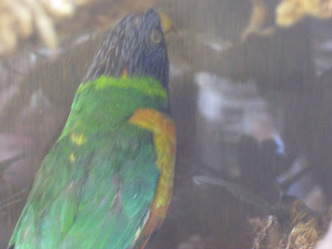
Case 5, Bird 28: Parrot
Parrots are birds of the roughly 350 species in 85 genera comprising the order Psittaciformes, found in most warm and tropical regions. Also known as psittacines, they are usually grouped into two families: the Psittacidae (true parrots) and the Cacatuidae (cockatoos). Parrots have a pan-tropical distribution with several species inhabiting the temperate Southern Hemisphere as well. The greatest diversity of parrots is found in South America and Australia. Characteristic features of parrots include a strong curved bill, an upright stance, strong legs, and clawed zygodactyl feet. Most parrots are predominantly green, with other bright colors, and some species are multi-colored. Cockatoo species range from mostly white to mostly black, and have a mobile crest of feathers on the top of their heads. Most parrots are monomorphic or minimally sexually dimorphic. Extant species range in size from the Buff-faced Pygmy-parrot, at under 10 gm (0.35 oz.) in weight and 8 cm (3.2 inches) in length, to the Hyacinth Macaw, at 1.0 meter (3.3 feet) in length, and the Kakapo, at 4.0 kg (8.8 lbs) in weight. They are the most variably sized bird order in terms of length. The most important components of most parrots’ diets are seeds, nuts, fruit, buds and other plant material, and a few species also eat insects and small animals, and the lories and lorikeets are specialised to feed on nectar from flowers, and soft fruits. Almost all parrots nest in tree holes (or nestboxes in captivity), and lay white eggs from which emerge altricial (helpless) young. Parrots, along with crows, jays and magpies, are some of the most intelligent birds, and the ability of some parrot species to imitate human voices enhances their popularity as pets. Trapping of wild parrots for the pet trade, as well as other hunting, habitat loss and competition from invasive species, have diminished wild populations, and parrots have been subjected to more exploitation than any other group of birds. Recent conservation measures to conserve the habitats of some of the high-profile charismatic parrot species has also protected many of the less charismatic species living in the ecosystem.(Wikipedia) Can you identify the spices of Parrot? Go to our Unidentified Birds page and let us know.
Venezuelan Troupial

Case 5, Bird 29: The Venezuelan Trouplail
The Venezuelan Trouplial (Icterus icterus) is the national bird of Venezuela and one of about 25 or so species of “New World Orioles”. The Troupial is fairly large in size, with a long tail and a bulky bill. It has a black head and upper breast. The feathers on the front of the neck and upper breast stick outward, making an uneven boundary between the black and the orange of the bird’s lower breast and underside. The rest of the orange color is found on the upper and lower back, separated by the black shoulders. The wings are mostly black except for a white streak that runs the length of the wing when in a closed position. The eyes are yellow, and surrounding each one, there is a patch of bright, blue, naked skin. Troupials inhabit dry areas like woodlands, gallery forest, dry scrub, llanos and open savannah where they forage for insects and a wide variety of fruit. Generally they can be found in central South America with some of the subspecies to the northern and eastern extremes of the continent. (Wikipedia)
American Redstart
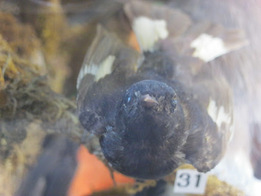
Case 5, Bird 31: The American Redstart
The American Redstart is a New World warbler. They breed in North America, across southern Canada and the eastern USA. These birds are migratory, wintering in Central America, the West Indies, and northern South America. They are very rare vagrants to western Europe. This species is unrelated to the Old World redstarts. This species derives its name from the male’s red tail, start being an old word for tail. The American Redstart is 12 cm long and weighs 8.5 g. The breeding males are unmistakable, jet black above apart from large orange-red patches on their wings and tails. Their breast sides are also orange, with the rest of their underparts colored white. In their other plumages, American Redstarts display green in their upperparts, along with black central tails and grey heads. The orange patches of the breeding males are replaced by yellow in the plumages of the females and young birds. The breeding habitats of these birds are open woodlands or scrub. These habitats are often located near water. These birds nest in a low are of a bush, laying 2-5 eggs in a neat cup-shaped nest. These birds feed on insects which are usually caught by flycatching. American Redstarts also have been known to catch their insect prey by gleaning it from leaves. This is a very active species. The tail is often held partly fanned out. (Wikipedia)
Bearded Bellbird
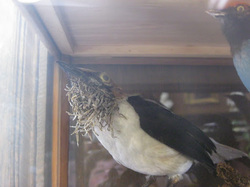
Case 5, Bird 32: The Bearded Bellbird
The Bearded Bellbird is also known as the Campanero or Anvil-bird, is a passerine bird which occurs in tropical northern South America. There are two subspecies; the nominate taxon, P. a. averano, in northeastern Brazil and P. a. carnobarba in Venezuela, Trinidad, extreme northeastern Colombia, western Guyana and far northern Brazil. This cotinga occurs in humid forests and woodland. It is mainly resident, but some populations take part in altitudinal migrations; breeding at altitudes of up to 1900 m (6250 ft) and spending the non-breeding season in the lowlands. It is a localised and uncommon bird in Venezuela, but is fairly common in Trinidad. The nominate race is relatively rare due to extensive habitat destruction in its range and heavy trapping for the cagebird trade. Like other cotingas, the Bearded Bellbird has a broad hooked-tipped bill, rounded wings, strong legs and a striking appearance. The male is approx 28 cm (11 in) long, and weighs 180 g (6½ oz). His plumage is white or greyish-white apart from the black wings and warm brown head. He sports a grotesque “beard” of un-feathered, black mossy wattles. The female is smaller, at approx. 27 cm (10½ in) and 130 g (4½ oz). Her upperparts are olive-green (duskier on the head), most of the underparts are yellow streaked with green, and the vent is pure yellow. She lacks the facial wattles (“beard”). Both sexes have dark eyes, a black bill and grey to black legs. These arboreal bellbirds feed entirely on fruit and berries, mainly taken on the wing. Lauraceae and Burseraceae are particularly favoured, and the young are fed regurgitated Lauraceae by the female. The males’ advertising calls are a very loud dull Bock repeated every few seconds and a somewhat less loud, metallic hammering tonk-tonk-tonk-tonk. Additionally, a number of regional calls are known, e.g. an unmusical, almost hissing, bisset in southern Venezuela and a disyllabic teek-terong in northern Venezuela. Apparently, the last mentioned call is no longer heard in Trinidad. The female is essentially silent. The flimsy nest of twigs is built by the female and usually placed in the outer branches of a tree. The single brown-mottled, light tan egg is incubated entirely by the female, leaving the polygamous male free to spend much of his time advertising with his distinctive songs. Laying season varies over its range; April-Nov. in Trinidad and May-Sep. in N. Venezuela. The first recorded egg was discovered near Cumaca, Trinidad, in the mid-1950s. (Wikipedia)
Red Capped Finch
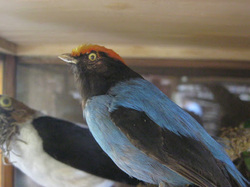
Case 5, Bird 33:
Believed to be a Red Capped Finch has this bird been correctly Identified? Let us know by going to our Unidentified birds page.
